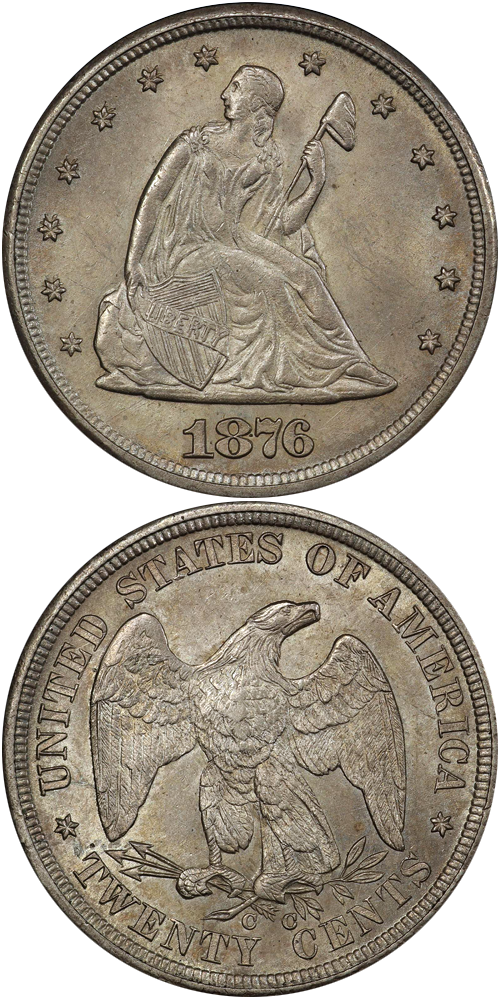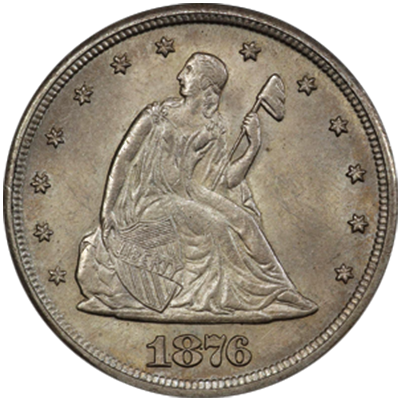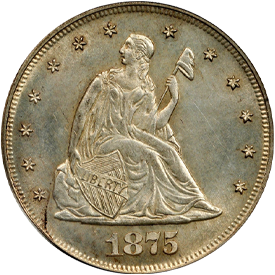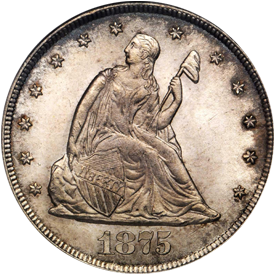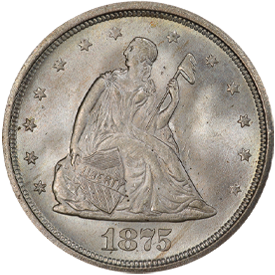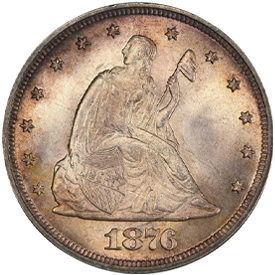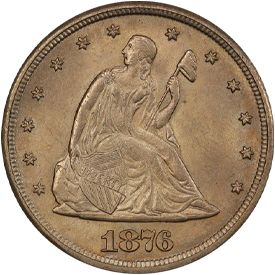Designed by: William Barber (obverse after Christian Gobrecht)
Issue Dates: 1875-1876
Composition: 90% silver, 10% copper
Diameter: 22 mm
Weight: 5.00 grams (77.16 grains)
Edge: Plain
Business Strike Mintage: 1,349,840
The Act of March 3, 1875 authorized the twenty-cent piece. It was felt that the denomination would find an enthusiastic reception in the West, but it was soon learned that the public confused the pieces with quarter dollars of approximately the same diameter. The obverse design features Christian Gobrecht's motif of Miss Liberty seated, stars surrounding, and the date below. The reverse is a new motif by William Barber and depicts a perched eagle, somewhat similar in configuration to that used on the Trade Dollar, surrounded by UNITED STATES OF AMERICA and the denomination expressed as TWENTY CENTS. The edge is plain, unlike other silver denominations of the era.
The type set collector will gravitate toward an example of 1875-S, the issue which is most often seen. Specimens are readily available in grades from Very Good to Extremely Fine. AU pieces are scarce, and Uncirculated coins are quite elusive. Truly superb Uncirculated pieces are rare. The striking is apt to be erratic, and often pieces will show lightness of impression, particularly on the eagle on the reverse and on the Liberty Seated figure and stars on the obverse. Many Philadelphia Mint business strike coins in higher grades exhibit prooflike surfaces. Proofs are available of the four Philadelphia issues 1875 through 1878.
Further Reading
As a regular denomination the twenty-cent piece had the shortest life of any United States coin. Pieces were first minted in 1875 and last struck in 1878, a span of just four years!
The denomination was contemplated earlier. In 1874 extensive pattern designs were prepared. Additional patterns were issued early the following year. As it turned out, the patterns were redundant, for when twenty-cent pieces were regularly issued for circulation in 1875 the obverse was merely a copy of the Liberty Seated motif used on other issues of the period (the quarter, for example), and the reverse portrayed an eagle copied from that used on the contemporary trade dollar (first issued for circulation in 1873).
In general appearance the twenty-cent pieces are quite similar to Liberty Seated quarters, the main differences being that the stars on the obverse of the twenty-cent piece are slightly smaller in proportion, the edge is plain, and the eagle is differently formed (but is perched and is somewhat similar to that used on the quarter).
As can be imagined, the twenty-cent piece was confused with the quarter dollar by the public. Operators of ferry boats, streetcar lines, and other places of public accommodation reported giving the wrong change when operators hastily assumed the unfamiliar twenty-cent piece was a quarter during the rush of business. "Those who have not learned the lessons of history are condemned to repeat its mistakes;" Santayana observed, and in 1979 the much-heralded (by the government) Susan B. Anthony dollar met a similar public reception – the piece was close to a quarter dollar in shape and size, and much confusion resulted.
Nearly all of the twenty-cent pieces produced were of one issue, the 1875-S (mintage: 1,155,000 pieces). Next in line is the 1875-CC with a sharply lower mintage, just 133,290 coins. Trailing the mint age statistics for this year is the 1875 Philadelphia issue with a recorded production of 39,700, including 2,790 Proofs. The following year, 1876, saw just 15,900 struck at Philadelphia and 10,000 at Carson City. There was a surfeit of these coins in San Francisco, and no additional pieces were made at the facility.
The great rarity among twenty-cent pieces is the 1876-CC. Although 10,000 of these were struck, it is believed that nearly all went to the melting pot. As a result, fewer than two dozen exist today. Most of these are in Choice Uncirculated grade and may have been saved for assay purposes. During the late 1950s a group of four of these came to light in a Baltimore safe deposit box and were handled by the writer.
An interesting feature of the 1876-CC is that all of the letters in the word LIBERTY are sharply doubled due to a shifting in the master die during the preparation of the coinage die. This distinctive characteristic has effectively eliminated the possibility of making "1876-CC" twenty-cent pieces by adding CC mintmarks to regular Philadelphia Mint issues.
The demand for the 1876-CC twenty-cent piece has been intense over the years. While a number of other coins in the American series may be of greater rarity, the appeal of the 1876-CC is that the acquisition of this single coin makes it possible to have a complete collection of pieces of this denomination.
Most of the demand for twenty-cent pieces today can be attributed to the desire and necessity to obtain a representative example for inclusion in a type set of American coinage. The 1875-S, the most plentiful issue, is the most likely candidate in this regard. Reflective of this demand for type coins, the market prices have adjusted themselves in recent years (particularly since 1960) so that much scarcer issues such as 1875, 1875-CC, and 1876 are available for only slightly less than the far more plentiful 1875-S. When collecting coins by design types first became popular around 1960, numismatists gravitated toward the common dates, which at the time sold for much less than rare dates. In the present market one can have the pleasure of displaying a scarcity or rarity for only slightly more than a common issue. This has appealed to many.
As twenty-cent pieces did not circulate for an appreciable time after the 1870s, most specimens received relatively little wear. Grading is complicated by a characteristic which is unique to the twenty¬ cent piece among regular issue coins of the Liberty Seated design (although the 1836 pattern Gobrecht silver dollar has the same feature): the word LIBERTY is raised on the twenty-cent piece rather than recessed or incuse (as it is on the Liberty Seated dime, quarter, half dollar, and silver dollar). Therefore, different grading standards must be used for the twenty-cent denomination.
For years, the rule of thumb has been that "full LIBERTY" is a requirement for a Liberty Seated silver coin to grade Fine. It was then realized, once grading was studied closely, that twenty-cent pieces with LIBERTY just barely visible were apt to have the rest of the coin – the other lettering, the feathers of the eagle, and the like, with the sharpness of a coin in much higher grade. In other words, using the LIBERTY benchmark was inconsistent.
This anomalous LIBERTY situation was recognized by James F. Ruddy when he wrote the Photograde book in 1970. When the Official ANA Grading Standards for United States Coins book made its appearance in 1977 the same procedure was followed. Under Photograde and ANA grading criteria three or more letters in LIBERTY must be visible to merit the Fine designation. A full LIBERTY, in the minimum sense, indicates Very Fine.
Most circulated pieces seen today are in grades of Fine upward, with Fine to Extremely Fine or AU representing the main range. In the 1950s, when circulated examples of 1875-S could be obtained for $5 to $10 each, Michael Kolman, Jr., owner of the Federal Coin Exchange in Cleveland, thought it would be an interesting project to hoard as many of these as possible. He obtained several hundred of these, much to the amusement of his colleagues who wondered why anyone would want so many "common" coins in lower grades. But, as the interest in collecting coins by type increased, Mike was to have the last laugh – for they were all sold at a very hefty profit.
